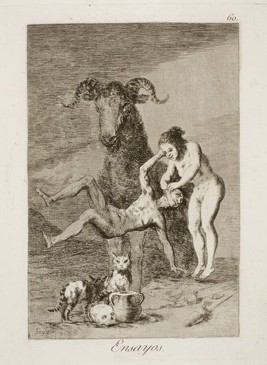- Cronología
- Ca. 1797 - 1799
- Dimensiones
- 210 x 166 mm
- Técnica y soporte
- Etching, aquatint and burin
- Reconocimiento de la autoría de Goya
- Undisputed work
- Ficha: realización/revisión
- 28 Oct 2010 / 29 May 2024
- Inventario
- 225
Ensayos. (at the bottom)
60. (in the upper right-hand corner)
Goya (signature in the bottom left-hand corner)
See Francisco de Goya y Lucientes, Painter.
A preparatory drawing of this engraving is in the Prado Museum.
A naked witch teaches her disciple, a man who is also unclothed, to rise into the air. To do so, she holds him by one ear and pulls on it, while the man holds on to the witch's head with one arm. The scene is witnessed by a billy goat who looks on majestically from the background, as well as by a cat standing in front of them and observing the spectator, very close to which is another feline walking towards the background. Next to the cat are a jug, a skull and two spindles, similar to those used by the witches in Caprice no. 44, Thin Spindle.
Compared to other engravings in the series, Goya gives a preponderance to etching over aquatint. He accurately depicts the anatomies of the figures, as well as the two animals. He constructs the upper part of the sky with short, very continuous horizontal strokes.
The manuscript in the Prado Museum explains this engraving as follows: "Little by little he is getting ahead of himself, he is already making his first steps and in time he will know more than the master". The manuscript of the National Library tells us about this print: "Leaving the labours of sex; continually scolding married people; stealing and always being like cats, are trials and beginnings of cabronería".
Goya creates an image intended to satirise the practices of witchcraft, as he has done on other occasions throughout the series of The Caprices. The billy goat has important analogies with the one in the work Aquelarre, which the Aragonese painter produced as part of the series of small paintings commissioned by the Duke and Duchess of Osuna to decorate their country house called The Caprice.
Although the subject of witches was a fashionable one in the late 18th century, especially among aristocrats, Goya used these characters to criticise certain human vices.
The plate is in rather poor condition, with the aquatint very worn (National Chalcography, no. 231).
-
Goya. La década de Los CaprichosMadrid1992organized by Real Academia de Bellas Artes de San Fernando sponsored by Fundación Central Hispano, Madrid, consultant editor Nigel Glendinnig. From October 26th 1992 to January 10th 1993cat. 27
-
Francisco de GoyaMuseo d'Arte ModernaLugano1996exhibition celebrated from September 22nd to November 17th.cat. 60, p.87
-
Ydioma universal: Goya en la Biblioteca NacionalBiblioteca NacionalMadrid1996from September 19th to December 15th 1996cat. 123
-
Francisco Goya. Sein leben im spiegel der graphik. Fuendetodos 1746-1828 Bordeaux. 1746-1996Galerie KornfeldBern1996from November 21st 1996 to January 1997cat. 66
-
Goya e la tradizione italianaFondazione Magnani RoccaMamiano di Traversetolo (Parma)2006consultant editors Fred Licht and Simona Tosini Pizzetti. From September 9th to December 3th 2006cat. 60, p.160
-
Goya. Opera graficaPinacoteca del Castello di San GiorgioLegnano2006exhibition celebrated from December 16th 2006 to April 1st 2007p.39
-
Goya e ItaliaMuseo de ZaragozaZaragoza2008organized by the Fundación Goya en Aragóna, consultant editor Joan Sureda Pons. From June 1st to September 15th 2008cat. 339
-
Goya et la modernitéPinacothèque de ParisParís2013from October 11st 2013 to March 16th 2014cat. 199
-
Goya: Order and disorderMuseum of Fine ArtsBoston2014cat. 166
-
Agen2019cat. 46
-
2022
-
Goya engravings and lithographs, vol. I y II.OxfordBruno Cassirer1964pp.137, cat. 95
-
Vie et ouvre de Francisco de GoyaParísOffice du livre1970p.183, cat. 571
-
El gran cabrón del aquelarre en GoyaBoletín del Museo e Instituto "Camón Aznar"ZaragozaIbercaja1981pp.23-37
-
Goya, la década de los caprichos: dibujos y aguafuertesMadridReal Academia de Bellas Artes de San Fernando1992pp.43-45, cat. 26-27
-
Goya. El capricho y la invención. Cuadros de gabinete, bocetos y miniaturasMadridMuseo del Prado1993p.213, fig. 149
-
Catálogo de las estampas de Goya en la Biblioteca NacionalMadridMinisterio de Educación y Cultura, Biblioteca Nacional1996p.105, cat. 150
-
El libro de los caprichos: dos siglos de interpretaciones (1799-1999). Catálogo de los dibujos, pruebas de estado, láminas de cobre y estampas de la primera ediciónMadridMuseo Nacional del Prado1999pp.310-313
-
ParísPinacoteca de París2013p. 265
-
Goya: Order & DisorderBostonMuseum of Fine Arts Boston Publications2014p. 254
-
Goya. In the Norton Simon MuseumPasadenaNorton Simon Museum2016pp. 42-75
-
AgenSnoeck2019p. 137
-
Museo de Bellas Artes de Badajoz y Diputación de Badajoz2022p. 46

